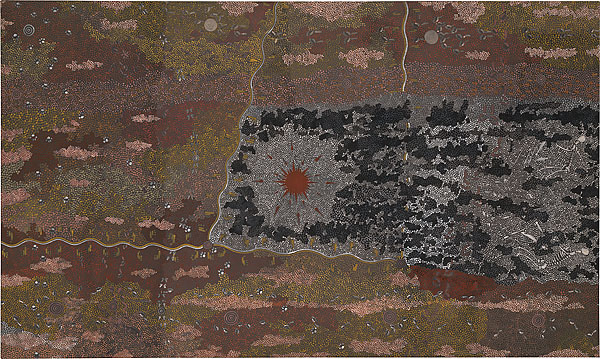Facts About Warlugulong
"Warlugulong" is a magnificent acrylic on canvas painting by Clifford Possum Tjapaltjarri, an esteemed Indigenous Australian artist. This masterpiece, which narrates the tale of an ancestral being named Lungkata along with eight other Dreamings, fetched an impressive A$2.4 million in 2007, when it was acquired by the National Gallery of Australia. The painting exemplifies the distinctive style developed by Papunya Tula artists in the 1970s, seamlessly blending landscape representation with ceremonial iconography.
The contemporary Indigenous Australian art movement began in Papunya in 1971, when men started illustrating their stories and traditions. Clifford Possum Tjapaltjarri, inspired by his brother Tim Leura Tjapaltjarri, emerged as one of the early pioneers of this movement. Created in 1977, "Warlugulong" is one of five works that symbolically map out Clifford's country, showcasing a rich visual narrative infused with traditional and ceremonial elements.
The painting depicts the story of Lungkata, the Bluetongue Lizard Man, who ignited the first bushfire to punish his sons. It incorporates elements from nine different Dreamings, each represented by distinct footprints and symbols. Compared to an earlier piece by Clifford Possum and his brother, "Warlugulong" focuses on a more confined geographical area, omitting certain elements to respect cultural sensitivities while appealing to a broader audience.
"Warlugulong" has a noteworthy sale history. It was initially purchased by the Commonwealth Bank in 1996 for A$1,200. In 2007, it was auctioned for an astonishing A$2.4 million and acquired by the National Gallery of Australia. This record-breaking sale underscored the growing significance and value of Australian Indigenous art in the market. Critics and art experts regard "Warlugulong" as a landmark piece, recognizing its national significance and artistic excellence.
The National Gallery of Australia's acquisition of "Warlugulong" as part of its 25th Anniversary Gifts Program highlights its importance in the realm of Indigenous Australian art. Furthermore, the sale of this painting played a pivotal role in advocating for the resale royalty scheme introduced by the Australian government in 2009, ensuring that artists and their families benefit from the rising value of their artworks.
